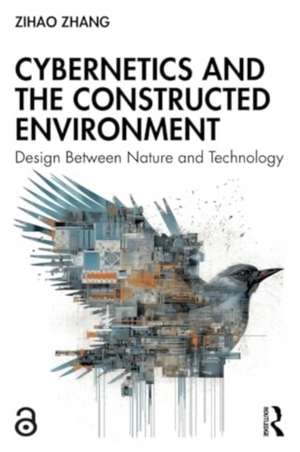Cybernetics and the Constructed Environment: Design Between Nature and Technology
Autor Zihao Zhangen Limba Engleză Paperback – 25 iul 2024
Chapters 8 and 9 of this book are freely available as a downloadable Open Access PDF at http://www.taylorfrancis.com under a Creative Commons Attribution-Non Commercial-No Derivatives (CC-BY-NC-ND) 4.0 license.
| Toate formatele și edițiile | Preț | Express |
|---|---|---|
| Paperback (1) | 303.41 lei 22-36 zile | +20.92 lei 5-11 zile |
| Taylor & Francis – 25 iul 2024 | 303.41 lei 22-36 zile | +20.92 lei 5-11 zile |
| Hardback (1) | 950.26 lei 43-57 zile | |
| Taylor & Francis – 25 iul 2024 | 950.26 lei 43-57 zile |
Preț: 303.41 lei
Nou
Puncte Express: 455
Preț estimativ în valută:
58.06€ • 60.78$ • 48.04£
58.06€ • 60.78$ • 48.04£
Carte disponibilă
Livrare economică 17-31 martie
Livrare express 28 februarie-06 martie pentru 30.91 lei
Preluare comenzi: 021 569.72.76
Specificații
ISBN-13: 9781032341750
ISBN-10: 1032341750
Pagini: 288
Ilustrații: 38
Dimensiuni: 156 x 234 x 28 mm
Greutate: 0.41 kg
Ediția:1
Editura: Taylor & Francis
Colecția Routledge
Locul publicării:Oxford, United Kingdom
ISBN-10: 1032341750
Pagini: 288
Ilustrații: 38
Dimensiuni: 156 x 234 x 28 mm
Greutate: 0.41 kg
Ediția:1
Editura: Taylor & Francis
Colecția Routledge
Locul publicării:Oxford, United Kingdom
Public țintă
Postgraduate, Professional, and Undergraduate AdvancedCuprins
Introduction: The Upscaling of the Cybernetic Imagination Part 1: The New Machine in the New Garden 1. A Transformation Formula 2. The Technology-Nature Edge: From Pastoralism to Anthropocene 3. The Human-Technology Edge: From Ready-made Artefacts to Dematerialized Humans 4. The Human-Nature Edge: The Three Waves of “Nature Study” 5. Posthumanism, Co-Production, and Assemblage Part 2: Posthumanism, the Environment and Intelligent Machines 6. Searching for Nonhuman Agency 7. From Nonhuman Agency to Speculative Ontology 8. Coproductive Intelligence Part 3: The Cybernetic Environment 9. Cybernetics and Landscape: From Uncertainty to Opportunity 10. Reframing Cybernetics 11. Sensing as Coding: The Episteme of the Digital Age 12. The Rise of Intelligent Agents: A Non-Model-Centric Paradigm 13. Actuating Leads to Attuning: Cultivated Wildness 14. Cultivated Wildness and Speculative Ecology Conclusion: Design and Cybernetic Environment
Notă biografică
Zihao Zhang is a designer, educator, and scholar in landscape architecture. He currently serves as an assistant professor and interim director of the landscape architecture program at the City College of New York.
Descriere
Grounded in contemporary landscape architecture theory and practice, this book blends examples from art, design, and engineering with concepts from cybernetics and posthumanism, offering a transdisciplinary examination of the ramifications of cybernetics on the constructed environment.
